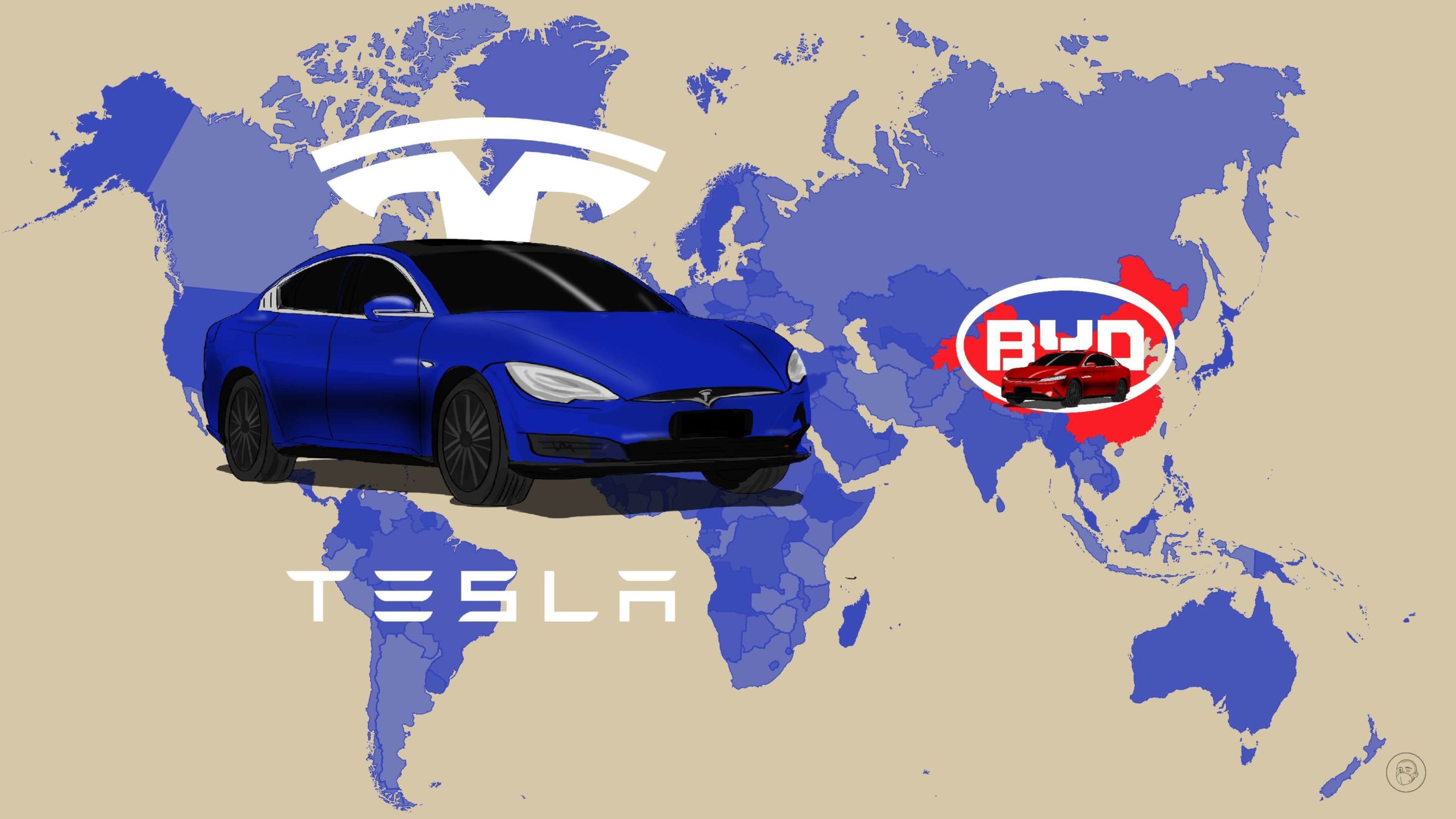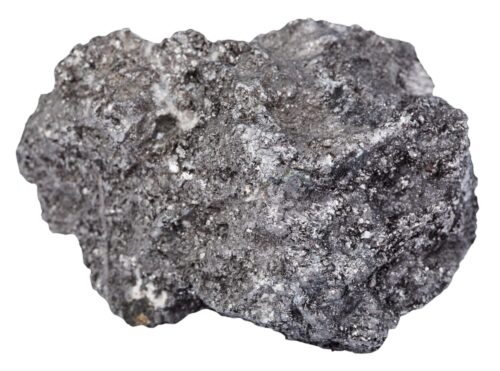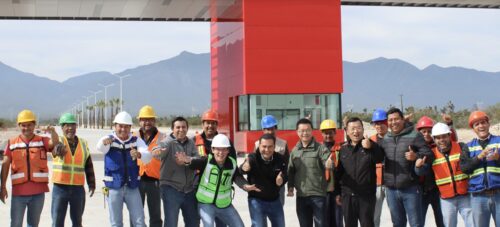Can BYD beat Tesla?
BYD is one of China’s first electric vehicle companies and it’s beating Tesla on its home turf, but can it replicate this success in foreign markets?

A two-horse race
In a 2011 Bloomberg interview, Tesla CEO Elon Musk was asked his opinion on BYD Auto (originally called Build Your Dreams, 比亚迪), a company from Guangdong Province that was founded as a battery manufacturer in 1995. Musk laughed, and said, “Have you seen their car?”
While Musk derided BYD as offering unattractive products and weak technology, its value had already been recognized by Warren Buffett’s Berkshire Hathaway, which acquired about 20% of the company in 2008. And Musk probably is not laughing at BYD anymore. In fact, Tesla’s vehicles in Europe now feature BYD batteries, and BYD has emerged as Tesla’s only real global competitor:
- During the first three quarters of the year, BYD sold 1.185 million electric vehicles (EVs) globally, a year-on-year increase of more than 160%, surpassing Tesla’s 909,000 units.
- In June, BYD’s market capitalization exceeded a trillion yuan (almost $150 billion), larger than Volkswagen Group and third on the list of auto giants behind Tesla and Toyota.
- In October, BYD sold a record 217,800 EVs in China, the eight month in a row of record sales, and a year-on-year increase of 168.78%.
China is the world’s most competitive EV environment, and BYD has a market share of about 30%, with at least 25 different models on sale, including hybrids and full EVs, ranging in price from 100,000 yuan ($13,841) to 1 million yuan ($138,417).
And the market wants more: In October, BYD founder and chairperson Wáng Chuánfú 王传福 stated that the company had a backlog of 700,000 orders, and that the delivery cycle for new vehicles is currently four to five months. The company is scrambling to expand production capacity: BYD has three major production bases in Shenzhen, Xi’an, and Changsha, and is currently constructing several more. In 2022, production capacity is expected to be about 3.05 million vehicles, 4.7 million vehicles in 2023, and 6.2 million vehicles in 2024. In 2021, BYD invested 37.34 billion yuan ($5.16 billion) on expanding production, and a further 36.13 billion ($5.00 billion) in the first half of 2022.
All of this means that BYD is indisputably one of the world’s two leading EV forces, along with Tesla. But raw sales numbers don’t tell you everything.
BYD sells more cars at lower profit margins
BYD may be selling more EVs than Tesla, but the American company is much more profitable, per unit and in total: For the first three quarters of 2022, BYD reported a net profit of 9.31 billion yuan ($1.28 billion), while Tesla over the same period declared a net profit of $8.87 billion. Indeed, during the first half of the year, BYD’s average vehicle price was 169,000 yuan ($23,392) with a gross profit margin of 16.3%, while Tesla’s average vehicle price was $55,700 (about 401,700 yuan), and the gross profit margin was as high as 30.6%.
In the first half of the year, the average passenger car sales price in China was 188,000 yuan ($26,000), and vehicles in the 90,000–190,000 yuan ($12,500–26,300) price range accounted for almost 50% of all sales. Most of BYD’s models are priced within 200,000 yuan ($27,700), while Tesla, NIO, and Li Auto barely have any models below 250,000 yuan ($34,600).
Control over lithium and battery supply chain
But BYD has some key advantages over Tesla in the long term: The Chinese company has a vertically integrated production chain and produces its own batteries. By the end of the third quarter of 2022, BYD had a total battery production capacity of 43.6 gigawatt hours (GWh), a year-on-year increase of 177%, accounting for a market share of 12.8%, and ranked third overall. (In 2021, the average capacity of a single EV battery was around 55 kilowatt-hours.)
Crucially, BYD seems to have more than enough lithium for all its batteries: In May this year, BYD had reportedly identified six lithium mines for acquisition in Africa, which would yield a million tons of lithium carbonate, enough supply to guarantee the company’s production for a full decade. Tesla has nothing like this.
Smart cars or efficient use of electricity?
There is another big difference between the two companies: Wang Chuanfu has said that electrification is the most important aspect of EVs, and intelligence comes second.
Over the past seven years, BYD and Tesla have both spent around 50 billion yuan (almost $7 billion) on research and development, but while Tesla has focused on vehicle intelligence with a range of software and hardware related to intelligent driving, BYD has focused on the three core aspects of electrification, namely, the battery, the motor, and the electric control system. It has also poured money into its blade batteries that launched in 2020 and claim to be safer than competing products.
But BYD models have been criticized for their lack of “smart” functionality. After its release in April 2021, the BYD Song Plus EV, for example, was originally advertised as supporting over-the-air (OTA) updates, i.e., cloud-based system upgrades that improve and update an EV’s performance and features. Many owners of this vehicle, however, have reported that the OTA function is basically useless. Since 2016, BYD has cooperated with Baidu and several other partners on on-board functionality and assisted driving, with mixed results. In terms of assisted or autonomous driving, moreover, BYD can’t hold a candle to Tesla.
China news, weekly.
Sign up for The China Project’s weekly newsletter, our free roundup of the most important China stories.
BYD’s baby steps in the global market
BYD is now on track to reach its ambitious sales target for 2022 of 1.2 million units. Yet BYD’s main market is still China, where it sells 97% of all the EVs it makes. To be clear, that is still an enormous market: In 2021, almost 7 million EVs were sold worldwide, of which a full 51% were sold in China; Germany (10.2%) and the U.S. (9.3%) were a long way behind.
But Tesla is already a global brand, with its sales distributed between the U.S. (40%), China (30%), and Europe (20%). BYD is looking to catch up:
- In September 2022, BYD entered the European market with the Han sedan, the SUV Tang, and the compact SUV Yuan Plus.
- Through the course of 2022, BYD entered markets in Australia (February), New Zealand and Japan (July), Cambodia and Israel (August), Thailand (September), and India (October). BYD’s EVs are now being sold in Europe, Africa, South America, the Middle East, and Asia.
- In October, BYD signed an agreement with European rental car company SIXT for the latter to purchase 100,000 BYD EVs over the next six years.
- BYD has also announced it was ordering eight cargo ships, at a total cost of 5 billion yuan ($688.89 million), to ship its vehicles to overseas markets.
Replicating the success BYD achieved in China, however, will be a much more difficult challenge in Europe. The market is growing rapidly in Europe (from 2016 to 2021, the compound annual growth rate of EV sales in Europe was 61%, higher even than in China). But Europe also has the most stringent automotive certification standards in the world, and with the high costs of vehicle modifications required, BYD’s low-cost business model will come under some strain. In Europe, moreover, BYD will collide head-on with Tesla: In September, Tesla surpassed Volkswagen as the leading seller of EVs in Germany.
However, Tesla’s CEO is preoccupied with Twitter and running SpaceX on the side. Although Elon Musk has taken full advantage of U.S. government subsidies, Tesla is unlikely to ever enjoy the government support of the kind that strategic Chinese companies can enjoy. And it’s highly unlikely Tesla will ever be able to catch up to BYD when it comes to controlling the supply chain from mine to car-on-motorway.
Wang Chuanfu might have the last laugh yet.






